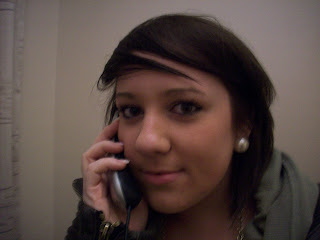The people featured in the story board are not the actual characters who are going to take part in the film. However, it is the location where the film will be shot. The costume will too be different.
1. This opening title is accompanied by the diagetic sound of Claire breathing heavily, obviously in distress. It is a black screen with credits, in a white font, such as, “a universal film..”
2.

This is part of the chase scene as Claire is running home. This is a long shot establishing her running out from the alley.
3. This is another black transition, still with the sound of Claire breathing heavily on top of it, implying that she is running from something. Again credits can seen on screen.
4.

This is still the chase scene as she is running home. This shot is a point of view shot to show her running from her perspective. The diagetic sound of her breathing and running can still be heard.
5.Again there is another blacktransition, displaying more of the credits. Diagetic breathing sounds are still on top of this for the audience to hear.
6.

The point of view shot continues as Claire turns around to show the villain chasing her. Her point of view shows a long shot the villain.
The camera will continue to change to her point of view as she runs and to her point of view as she turns around, looking at the villain pursuing her.
7. This is the last black transition in the sequence and shows the final credits, establishing to the audience information such as,who it is produced and directed by.
8.

A high angle shot is used for the camera to track Claire running down the street to her door. This type of shot portrays her vulnerability and isolation as the camera displays the length of the road and its emptiness.
9.

The camera continues to track Claire as she is running to her house. The long shot shows her coming up to her door.
10.

The camera then zooms in to a match on action shot of Claire opening the door. This establishes that she has reached her destination and has managed to escape from the villain who was chasing her.
11.

A midshot shows Claire entering the house, closing the door behind her and leaning against it. This midshot portrays the character in the change of scene and also the lighting as she is now inside. The camera angle and the way she leans against the door displays her fear and confused state of mind, obviously in shock about what has just happened.
12.

A long shot then illustrates her running up the stairs,where the camera follows her to the bathroom.
13.

This mid shot establishes the character walking into the bathroom and the change in scene.
14.

This close up, which is at a slight low angle displays Claire being sick in the toilet. This connotes to the audience her fear and worry about what has just happened and what could possibly follow due to this physical emotion.
15.


Both of these shots are point of view, and so the camera is at a high angle, over the shoulder shot. She washes her hands and dries them on the towel. This point of view shot continues as she lifts her head up look in the mirror.
16.

Another mid shot then shows Claire’s reflection in the mirror. The camera pauses on this for a few seconds to focus on the look that she has on her face, again to reinforce her fear and her thoughts. This is before the scene changes to a flashback of Claire and what she saw and why the villain was chasing after her.
17.

A quick cut transfers to a flash back, taking the audience back to the beginning scenes and displays Claire walking down the alley and a close up of Claire’s face. This illustrates her reaction of what she is looking at, however the audience still do not know what this is.
18.


This long shot shows the audience what Claire saw and why she was running. This is the victim that Claire witnessed the villain trying to kill and this is why she is so shocked.
The killer then slowly lifts his head up, looking a Claire. A clear indicator that he has recognised he has been seen
19.

A quick edit follows this to another close up of Claire. This displays a further reaction as she knows she has been seen. (This then transfers into a medium long shot as she goes to run)
20.

A long shot goes back to the killer where he gets up to pursue Claire.
21.

A point of view shot of Claire repeats what the audience saw at the beginning, verifying what happened and why she was running. The sound of her heavily breathing whilst running can be heard once more but is interrupted by the loud sound of the telephone ringing.
22.

Again, another quick edit cuts to a long shot of Claire. She sharply turns her head to sound of the phone, which appears to be us (the camera.) She hesitantly walks towards it with caution, obviously still traumatised about what she has seen.
23.


The camera tracks Claire as she goes into the room where the phone is. A medium shot shows her pick it up, where she pauses for a moment before saying anything. The camera then zooms in on her face as she says “hello.” The close up expresses to the audience her disturbed and panicked look, however, the audience do not know who is on the other end of the phone, leaving the opening sequence of this film on a cliff hanger
24. A quick cut then goes to a black screen where the title of the film (Payback) flashes suddenly up on screen. This is in the same style Writing as the opening credits.






























